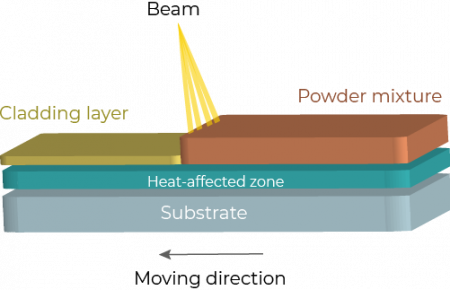
Electron Beam - Technology
Electron Beam is highly energy efficient and precise with respect to power density, focus, and deflection
Electron Beam Generation – Principle
Most commonly, a triode set-up is used to generate the electron.
The heating current IH causes the Tungsten filament to emitt electrons. These are accelerated by the acceleration voltage UA, between the cathode and the anode.
The Wehnelt cylinder applies the control voltage UW and allows very fast adjustments of the flux of electrons through the anode as an electron beam (EB).
The generation of a precise EB requires high vacuum conditions better than 10-4 mbar in the EB Generator chamber are mandatory.
Then the EB passes the electrical field of the focusing lense. The following deflection yokes enable a quasi inertia-free extremely dynamic and flexible handling and controlling of the beam properties with respect to geometry, focus levels, multi-process, multi-bed, oscillation figures, up-slope, down-slope, seam finding, seam tracking.
The vacuum (pressure, humidity) directly impacts the beam properties. This applies for the vacuum in the EB Generator as well as for the vacuum in the actual work chamber (see pictures below).
The vacuum is generated by specific pumps which evacuate the vacuum chamber and the housing of the EB Generator separately.
The vacuum chamber and its design shields the X-rays generated by the EB reliably in order to meet the safety requirements.
Evobeam’s electron beam machining systems generally features pumps that minimize the evacuation time to optimize productivity.


The following pictures display the impact of vacuum on the electron beam. The visible beams are actually atoms that have been energized by the electron beam and emitt photons. The electron beam itself is invisible.

High Vacuum: 5 x 10-4 mbar

Medium Vacuum: 5 x 10-2 mbar

Non-Vacuum: 1013 mbar
Electron Beam Fields of Application
Most common electron beam applications are: welding, drilling, cladding, surface treatment (e.g. hardening, surface structuring, engraving, polishing)
Electron Beam Welding / EB Welding

The electron beam creates very deep and slender weld with minimized heat input and warpage of the workpiece.
Electron Beam Drilling / EB Drilling

The use of electron beam technology in drilling significantly increases productivity.
The highly dynamic adjustment of the beam characteristics enables the drilling of holes with very different diameters and depths in one pass.
Electron Beam Cladding / EB Cladding

The Electron Beam enables precise dosing of additive material and adjustment of layer thickness.
This supports the exact control of the material properties with respect to formation and hardness.
Electron Beam Surface Treatment / EB Surface Treatment

The electron beam is not reflected from shiny surfaces.
The electromagnetic deflection and focusing of the electron beam is currently twice as fast as the mechanical deflection of the laser beam.
Therefore, the following methods of surface processes for mass production are applied:
- EB Hardening
- EB Surface Structuring
- EB Engraving
- EB Polishing

